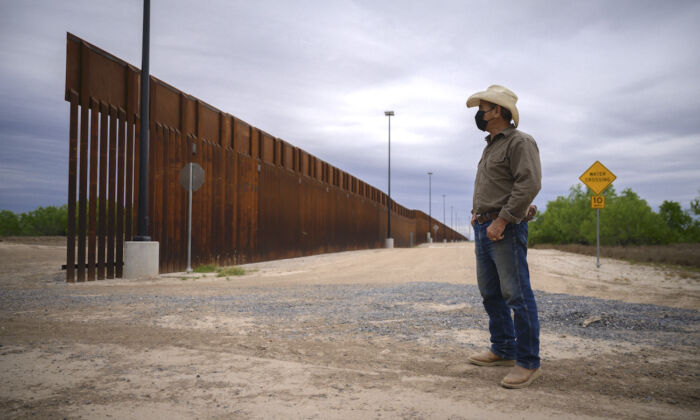By Autumn Spredemann
As a human tidal wave continues flowing across the U.S. southern border from Mexico, cattle ranchers in Texas scramble to deal with the destruction done by illegal immigrants and human traffickers.
There were 201,800 encounters between U.S. Border Patrol agents and illegal aliens along the southwest land border in April, according to data released by their office.
April 2022 marked the highest number of detentions on record for the month. Border agents in Texas handled the highest volume, arresting an average of 4,260 illegal immigrants per day.
In Victoria, along the upper Gulf Coast in Texas, Stephen Diebel and his family have been ranchers for five generations. Even 186 miles from the Mexico border, he has experienced issues with property damage from illegal border-crossers.
“Although we don’t see a lot of the foot traffic yet, we do see a lot of the [other] things, most commonly bailouts and the fences being cut,” Diebel told The Epoch Times.
He says ranchers closer to the border have it much worse. They suffer everything from destroyed livestock fences to broken water lines and armed intimidation from human traffickers and unlawful immigrants.
Diebel is also a vice president of the Texas and Southwestern Cattle Raisers Association (TSCRA) and the organization’s chair of the border security task force.
The association represents 17,500 members, including beef cattle producers, ranching families, and related businesses.
He explained that illegal immigrants and their transporters, many of whom are members of Mexican drug cartels, have even set fires on a rancher’s property.
“At the borders, they ranchers see even more extreme circumstances like water lines being cut and fires started just for detection or invasion purposes,” Diebel told The Epoch Times.
The practice of lighting fires carries an extra layer of danger since Texas is currently experiencing a years-long drought that directly affects more than 16 million people.
In March 2022, a series of wildfires burned more than 54,000 acres of land resulting in more than $23 million in agricultural losses, according to Texas A&M AgriLife Extension Service economists.
When it comes to livestock fences, illegal immigrants and their traffickers have one of two ways they handle the barriers: cutting and bailouts.
“When you have the cartel leading these groups across, they want to make it as easy as possible,” Jeremy Fuchs at TSCRA told The Epoch Times.
He elaborated that the goal is to walk straight through the property without climbing over anything. However, the cutting and removal of livestock fencing allows cattle to escape, sometimes into areas near busy roads, posing a threat to vehicle drivers and cattle alike.
It also equals considerable money lost when cows escape into the wilderness. A single head of cattle can represent up to $5,000 of revenue, depending on the cow’s weight, gender, and breed.
Both Fuchs and Diebel say knocking down entire fences on a ranch has become commonplace, costing thousands of dollars in repairs. This is especially prevalent when the immigrant groups loaded into vehicles are trying to avoid law enforcement.
“This is what they refer to as a bailout. They’ll drive through the fence to get as far away as they can and will all jump out of the truck and go hide in the woods,” Fuchs said.
Damage caused by bailouts and fence cuttings has already cost Texas ranchers thousands of dollars. The state has 248,800 farms and ranches totaling 130.2 million acres. Many of these are situated along the state’s 1,254 mile border with Mexico.
And with fortified livestock fencing costing upwards $2.50 per linear foot, the cost for repairs adds up fast.
Fuchs explained several TSCRA members have dealt with 20 to 30 bailouts in the past three months alone.
On top of that comes the cost of rebuilding broken water lines.
“As they are trying to hide, they are also trying to get the resources they need to survive this trek,” said Fuchs.
“A lot of times, we see them digging into and breaking water lines and things like that to get access to water without going up to a spigot by the house or a trough that’s in plain view.”
Reports of ranchers encountering armed intimidation from traffickers and illegal immigrants have created what some feel is an impossible uphill battle to protect their livelihoods.
Richard Guerra owns an 8,000 acre ranch in Starr County along a section of the Rio Grande that U.S. border officials consider the most volatile part of the entire southern border.
“I’m going to step lightly and tell you we do carry our guns. I’ve had armed intrusions here before,” said Guerra.
Earlier this year in March, Governor Greg Abbott dispatched around 30 National Guard members at intervals along U.S. Route 77 near private ranches as a deterrent for unlawful migrants and their transporters.
Last July, Abbott encouraged Texas ranchers and landowners in border communities suffering from the migration crisis to complete a survey to help identify damages as part of the state’s ongoing efforts to secure the border.
“Texas will continue using all available resources to prevent this mass illegal migration,” Abbott said in a post on Twitter.
House Representative Stephanie Bice introduced the Securing American Families from Exploitation at the Border, or SAFE border act in December 2021.
The new legislation aims to harness $75 million of construction funds that the administration of President Joe Biden hasn’t used to establish the Southern Border Landowner Security Grant Program.
Among the proposed benefits for besieged ranchers and landowners is funding for increased security against physical threats and property damage.
Additionally, there would be compensation for those who’ve experienced vandalism, theft, or other losses related to illegal immigration.
In February, the U.S. Department of Agriculture (USDA) Natural Resources Conservation Service (NRCS) in Texas announced financial assistance for farmers and ranchers in 34 counties along the border.
“We understand that the field and farming infrastructure damages along the border are costly and have a negative impact on our natural resources that our farmers and ranchers work hard to conserve,” Kristy Oates, an NRCS state conservationist, said.
Beyond property damage and armed intrusions from illegal immigrants and traffickers, Texas’ Attorney General Ken Paxton says the crisis has also created an unprecedented burden for U.S. taxpayers.
In his January lawsuit against the Biden administration for an unlawful 100 day freeze on deportations, Paxton revealed illegal immigration is costing Texans more than $850 million per year.
“The cost of illegal immigration is an unconscionable burden on the taxpayers of our great state. If we use the minimum estimated costs for services Texas provides to unlawfully present and undocumented aliens, taxpayers are shelling out an estimated $855 million every year,” Paxton said.
He added that Texans will always welcome those who immigrate to the United States through the appropriate legal channels, but that it’s simply impossible to keep forcing taxpayers to foot the bill for individuals who choose to “skip the line.”
“The point of our landowners is the frustration, they feel like no one is listening. It’s a really delicate issue but a very important issue,” Diebel said.






